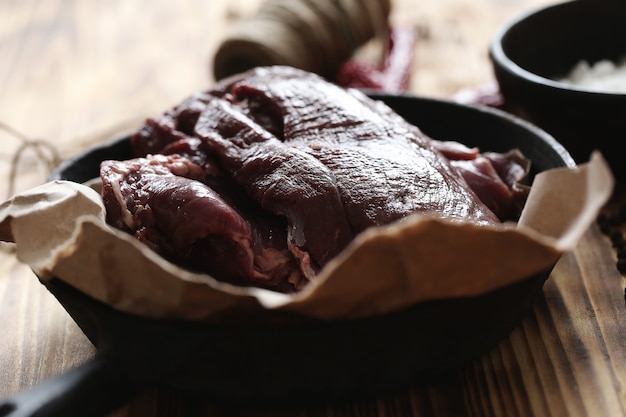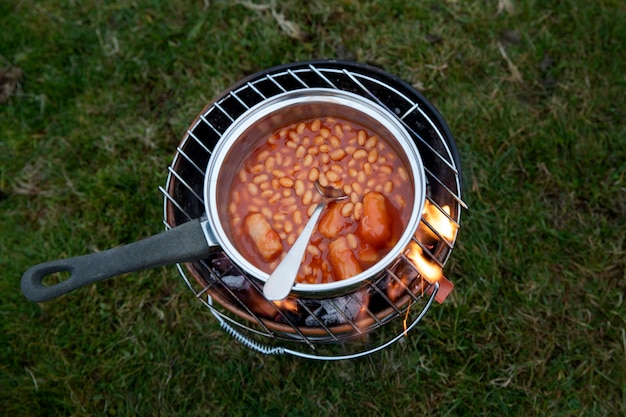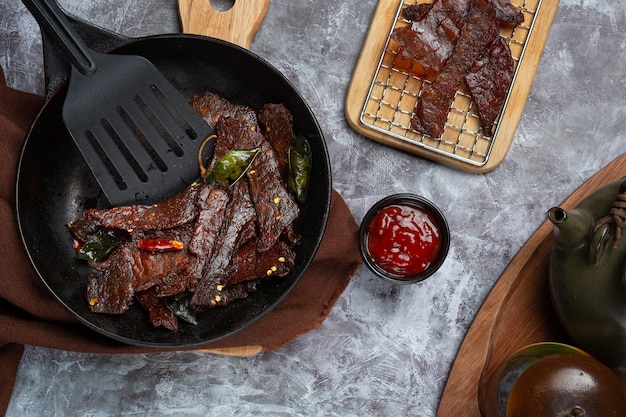Let’s talk about beef brisket, a culinary champion that brings a sense of comfort and warmth to any occasion. I’m a firm believer in the magic of slow cooking, and there’s something truly special about a perfectly cooked brisket. It’s the kind of meal that fills your home with an inviting aroma and evokes a sense of homey nostalgia. For years, I held back, assuming it was a complex dish reserved for culinary masters. Turns out, I was wrong. It's incredibly easy, and once you’ve tasted a melt-in-your-mouth, fall-off-the-bone brisket from your very own crock pot, you’ll be singing its praises, too.
(Part 1) The Crock Pot: Your Kitchen's Best Friend

The crock pot is a real game-changer, a kitchen hero that simplifies cooking and delivers incredible results. It’s like a culinary time machine, transforming tough, humble cuts of meat into tender, flavorful masterpieces. You just toss in your ingredients, set it on low, and let the slow cooker work its magic. By the time dinner rolls around, you’ve got a delicious, hearty meal ready to go, with minimal effort on your part.
Why the Crock Pot is a brisket master
Let's be honest, brisket isn't exactly known for being the most tender cut of meat. It's full of connective tissue that needs time to break down. This is where the slow cooker steps in as the ultimate hero. The low and slow cooking process allows the moisture to penetrate the meat, breaking down those tough fibers and transforming it into a juicy, flavorful masterpiece. It's like witnessing culinary alchemy, turning a seemingly ordinary cut into something that practically melts in your mouth.
(Part 2) Selecting the perfect brisket

Before you embark on your brisket journey, choosing the right cut is key. Don't worry, it's not as intimidating as it sounds. You've got two primary options:
Point vs. Flat: A Brisket Showdown
The point is the thicker, more flavorful end of the brisket. It boasts a higher fat content, resulting in a richer, juicier texture. However, it can be a bit tougher to cook evenly due to its thicker shape. The flat, on the other hand, is thinner and leaner, making it easier to cook evenly. However, it tends to be drier, lacking that intense richness.
Personally, I'm a huge fan of the point. I love that extra tenderness and richness. Plus, it's perfect for slicing and serving with a flavorful gravy. But ultimately, it's your choice! If you prefer a leaner cut, the flat is a great option. You can even get a combination cut, which gives you a bit of both worlds.
No matter which cut you choose, look for a brisket that’s well-marbled. You want to see a good amount of fat throughout the meat. This helps to keep it moist and flavorful. Imagine it as the meat’s natural self-moisturizer, ensuring a succulent and delicious end result.
Finding the best brisket: Your Shopping Guide
Now, here’s where a bit of detective work pays off. Don’t just grab the cheapest brisket on the shelf. Take a little time to look around and find one that looks good. It's like choosing a good book - you want to find one that appeals to you. The meat should be a nice, deep red color, and the fat should be white and firm. It shouldn’t have any discoloration or strange smells.
Sometimes the best deals can be found at the butcher counter or from a local farm. Don’t be afraid to ask around. I once found an incredible brisket at a small butcher shop, a hidden gem that blew my mind. It was far superior to anything I'd found at the supermarket, and it’s become my go-to spot ever since.
(Part 3) Preparing the Brisket for Crock Pot Glory

Okay, you've got your brisket. Now, let's get it prepped and ready for its slow cooker transformation!
Trimming the Fat: A Balancing Act
First things first, we need to trim some of the excess fat off. You want a nice layer of fat on the brisket to keep it moist, but you don’t want it to be too thick. I find that about ?? inch is perfect. Think of it as a delicate balance between richness and texture.
You can trim the fat with a sharp knife, or you can use kitchen shears. Just be careful not to cut all the way through the meat. And hey, don’t discard that trimmed fat! You can render it down and use it to make a rich and flavorful gravy later on. It's like turning waste into culinary gold.
Seasoning: The Flavor Symphony
Now, it’s time to season the brisket. This is where you can unleash your creativity and make your dish truly your own. But I find that a simple salt and pepper seasoning is perfect for letting the natural flavor of the meat shine through. I like to use a coarse sea salt and freshly ground black pepper. Just rub it all over the brisket, making sure to get into all the nooks and crannies.
Feel free to add other seasonings if you like. If you enjoy a bit of heat, a sprinkle of cayenne pepper can add a delightful kick. For a savory boost, garlic powder and onion powder are always welcome additions. I’ve even experimented with a touch of smoked paprika for a smoky, earthy depth of flavor. It all depends on your taste buds!
(Part 4) The Crock Pot Process: A Symphony of Flavor
The brisket is seasoned and ready to go. Now it’s time to let the crock pot work its magic.
Layering the Brisket: A Foundation of Flavor
Place the seasoned brisket in the bottom of the slow cooker. If you're using a point cut, you'll want to lay it fat-side up. This helps to keep the meat moist and tender, allowing the fat to render and baste the brisket as it cooks.
Now, it’s time to add the ingredients that will create a symphony of flavors.
Adding Flavor: A Culinary Ensemble
There are countless ways to add extra flavor to your brisket. Here are some of my favorites:
- Onions and Garlic: A Classic Duo A classic combo that’s hard to beat! I like to use one large onion, sliced or chopped, and a couple of cloves of garlic, minced. They add a sweet and savory depth of flavor to the brisket.
- beef broth: The Moisture Maestro A good quality beef broth will add moisture and richness to the brisket. I usually use about 1-2 cups, depending on the size of the brisket.
- Worcestershire Sauce: A Savory Touch This adds a savory, umami flavor that complements the beef perfectly. I use about 2-3 tablespoons.
- bbq sauce: A Bold Statement If you prefer your brisket with a bit of a kick, you can add a cup or two of your favorite BBQ sauce. I like to add it towards the end of the cooking time, just to glaze the brisket and add a delicious shine.
- Smoked Paprika: A Smoky Embrace For a smoky, earthy flavor, try adding a tablespoon or two of smoked paprika. It adds a delightful complexity to the dish.
- Other Spices: A Culinary Palette You can also experiment with other spices, like cumin, chili powder, or thyme. Just remember to use them sparingly, allowing the natural flavors of the brisket to shine through.
Remember, this is just a starting point. Feel free to experiment with different combinations of ingredients and see what you like best. The beauty of cooking is that it's an ongoing journey of exploration and discovery.
Cooking the Brisket: A Slow and Steady Transformation
Once everything is in the slow cooker, cover it and cook on low for 8-10 hours, or on high for 4-6 hours. I usually cook it on low for at least 8 hours. This gives the meat plenty of time to become tender and juicy. Think of it as a slow and steady transformation, resulting in a culinary masterpiece.
(Part 5) Checking for Tenderness: The Signs of Success
After 8 hours, your brisket should be cooked through. But how do you know it’s really tender and ready to eat? Here are a couple of ways to check:
The Fork Test: A Simple Gauge
Insert a fork into the thickest part of the brisket. If the fork goes in easily and the meat pulls apart with little resistance, it’s cooked.
The Shred Test: A More In-Depth Check
If the fork test is a little inconclusive, try the shred test. Use two forks to shred the meat. If it easily shreds, it’s cooked to perfection. This is a great way to see if the meat is falling apart, a sign that it’s reached peak tenderness.
(Part 6) Resting the Brisket: Allowing the Juices to Redistribute
Once the brisket is cooked, take it out of the slow cooker and let it rest for at least 30 minutes. This is a crucial step, because it allows the juices to redistribute throughout the meat, resulting in a more evenly moist and flavorful brisket. It also makes it easier to slice, preventing the meat from crumbling.
(Part 7) Slicing and Serving: The Culinary Finale
Now it’s time for the most satisfying part – slicing and serving. You can use a sharp knife to slice the brisket against the grain. This will make the meat even more tender and easier to eat. If you’re having a party, you can slice the brisket into thin slices and serve it on a platter.
How to slice brisket: A Guide to Perfection
First, look at the grain of the meat. You'll see lines running across the brisket, those are the grain. Slice your brisket across these lines. By slicing this way, you're cutting across the muscle fibers, which makes the meat much easier to chew. It's like a culinary secret for achieving a melt-in-your-mouth experience.
Serving Ideas: A culinary adventure
There are so many delicious ways to serve brisket. Here are a few of my favorites:
- With mashed potatoes and gravy: A classic combo that never fails. The creamy mashed potatoes complement the richness of the brisket, while the gravy adds a layer of savory delight.
- On toasted buns with BBQ sauce: Makes for a delicious and satisfying sandwich. The toasted bun provides a delightful contrast to the tender brisket, while the BBQ sauce adds a tangy kick.
- In tacos: Add some shredded brisket to your favorite taco recipe. The tender brisket adds a delicious, hearty element to your tacos, making them truly satisfying.
- In salads: Slice the brisket thinly and add it to a salad for some protein and flavor. It's a great way to add a hearty element to your salad while enjoying the deliciousness of brisket.
(Part 8) Making Gravy: The Perfect Finishing Touch
Now, let’s talk about gravy. A good gravy really elevates the brisket, taking it to the next level. You can make a simple gravy using the juices from the slow cooker and some flour.
Simple Gravy Recipe: A Culinary Shortcut
Here’s how to make a quick and easy gravy:
- Pour the juices from the slow cooker into a saucepan. This is the foundation of your gravy, capturing all the essence of the brisket’s flavor.
- Whisk in 2-3 tablespoons of flour until smooth. This will help to thicken the gravy and create a velvety texture.
- Bring the mixture to a boil, stirring constantly. This ensures that the flour cooks properly and doesn't leave any lumps.
- Reduce heat and simmer for 5-10 minutes, or until the gravy has thickened. This allows the flavors to meld and the gravy to reach its perfect consistency.
- Season to taste with salt and pepper. Adjust the seasonings to your liking, creating a gravy that perfectly complements the brisket.
For a richer gravy, you can use the rendered fat from the brisket. Simply add it to the saucepan before you whisk in the flour. This will add an extra layer of richness and depth of flavor to your gravy, elevating it to a new level.
(Part 9) Leftovers: The Gift That Keeps on Giving
Okay, let’s talk about leftovers. Now, brisket is so good that you might not have any, but if you do, don’t throw them away! Leftover brisket is a culinary treasure waiting to be repurposed.
Leftover Brisket: A Culinary Treasure
Leftover brisket is perfect for sandwiches, tacos, or salads. You can also add it to soups and stews, adding a hearty and flavorful touch. I’ve even been known to make brisket hash for breakfast – a savory and satisfying way to start the day.
Storing Leftovers: Keeping the Brisket Fresh
To store leftovers, place the brisket in an airtight container and refrigerate for up to 4 days. You can also freeze it for up to 3 months. Just make sure to thaw it in the refrigerator before reheating.
FAQs: Your Crock Pot Brisket Questions Answered
Here are some frequently asked questions about cooking brisket in a crock pot:
| Question | Answer |
|---|---|
| Can I cook brisket in a slow cooker on high? | Yes, but you need to shorten the cooking time. Cook brisket on high for 4-6 hours. Just keep an eye on it to make sure it doesn't dry out. |
| Can I add vegetables to the slow cooker with the brisket? | Yes, you can! Add them towards the end of the cooking time to avoid them becoming mushy. Root vegetables like carrots and potatoes are great additions to the slow cooker with brisket. |
| How can I prevent my brisket from drying out? | The key to preventing brisket from drying out is to use a good amount of fat and liquid in the slow cooker. You can also wrap the brisket in aluminum foil before cooking it, to help lock in the moisture. Think of it as a culinary hug, keeping the brisket moist and tender. |
| What is the best way to reheat leftover brisket? | The best way to reheat brisket is in the oven. Pre-heat your oven to 350 degrees F (175 degrees C). Place the brisket on a baking sheet and bake for 15-20 minutes, or until heated through. You can also reheat brisket in a microwave, but it might become a bit dry. |
| How do I know if my brisket is cooked? | The best way to check if your brisket is cooked is to use a meat thermometer. The internal temperature should reach at least 190 degrees F (88 degrees C). You can also use the fork test or the shred test. |
So there you have it, my complete guide to making delicious and easy Crock Pot Beef Brisket. I hope this has inspired you to try it out! It’s a real crowd-pleaser, and it’s a dish that you can feel good about serving. Give it a go and let me know how it turns out!
Everyone is watching

Corn on the Cob: The Ultimate Guide to Perfectly Cooked Ears
Healthy MealsAh, corn on the cob. Just the name evokes images of sunny days, barbecues, and that sweet, juicy flavour that ...

Perfect Pork Roast Oven Cooking Time: A Guide to Delicious Results
Healthy MealsThere's something truly satisfying about a perfectly roasted pork. The aroma alone is enough to make your mout...

Ham Cooking Time: How Long to Bake, Smoke, or Boil a Delicious Ham
Healthy MealsAh, ham. It's a classic, isn't it? A real crowd-pleaser, especially around holidays. And when done right, it'...

Scallops: The Ultimate Guide to Perfect Cooking
Healthy MealsAh, scallops. Those delicate, sweet, and utterly delicious morsels of the sea. They hold a special place in my...

Spaghetti Squash: The Ultimate Guide to Cooking and Serving
Healthy MealsRemember that time you saw spaghetti squash at the supermarket, looking all bumpy and strange, and thought, "W...
